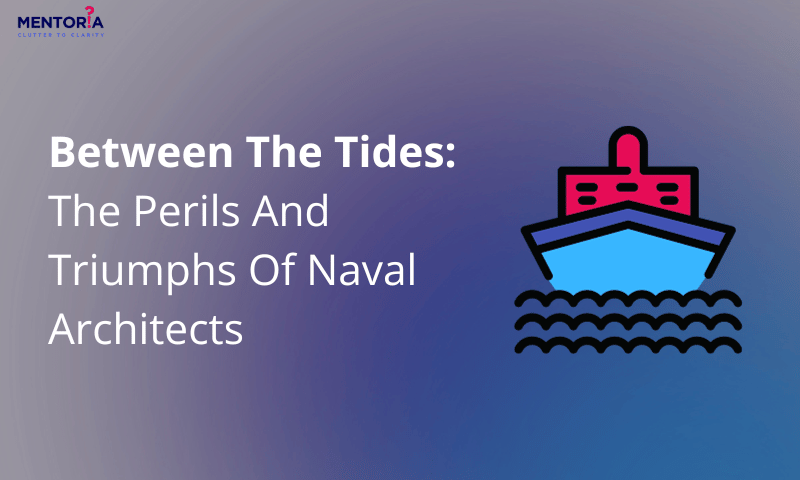Between The Tides: The Perils And Triumphs Of Naval Architects

Amidst the relentless waves, where innovation collides with nature’s brute force, a silent group of architects shapes vessels that dance gracefully between the tides. Naval architects, the unsung magicians of maritime engineering, conjure both perils and triumphs on the canvas of open waters. Their canvas isn’t just wood, steel, and bolts; it’s the dreams of explorers, the ambitions of trade, and the safety of lives at sea. As we delve into the realm of these unassuming yet extraordinary creators, be prepared to unravel the riveting saga of a profession that merges artistry, science, and the call of the oceans into vessels that dare to challenge the seas themselves.
Understanding The Role Of A Naval Architect
Before we dive into the challenges, let’s grasp the vital role of a naval architect. These talented individuals are engineers, designers, and problem solvers combined. Naval architects possess a multifaceted skill set that goes beyond conventional engineering. Their expertise extends from conceptualising the initial design to overseeing the construction and ensuring operational efficiency. They meticulously consider factors such as stability, hydrodynamics, structural integrity, and safety regulations. Collaborating with a diverse team including marine engineers, shipbuilders, and interior designers, naval architects create vessels that balance aesthetics, functionality, and safety.
These professionals play a pivotal role in shaping the maritime industry’s future. They embrace cutting-edge technologies like computer-aided design (CAD) software and simulation tools to optimise ship designs for fuel efficiency and environmental impact. With a keen eye for innovation, naval architects are at the forefront of developing sustainable solutions, including alternative propulsion systems and lightweight materials, to navigate the evolving demands of the maritime world.
Moreover, the role of a naval architect transcends ship design; it extends to modifying and improving existing vessels, ensuring compliance with international regulations, and conducting thorough risk assessments. Their work touches various sectors, from naval defence and commercial shipping to offshore energy exploration and cruise tourism. As the maritime landscape continues to evolve, naval architects remain at the helm of innovation, shaping vessels that navigate the oceans with precision, resilience, and a touch of engineering artistry.
Challenges Of A Naval Architect
#1: Safety And Stability At Sea
Imagine constructing a floating city on water, ensuring it remains stable in the face of turbulent waves and unpredictable weather. Ensuring the safety of passengers, crew, and cargo is the foremost challenge for naval architects. Statistics show that ship accidents are on a declining trend, thanks to innovative safety measures implemented by naval architects in vessel designs. The number of ship accidents has declined by 50% in the past decade. The average loss of life in ship accidents has also declined by 50% in the past decade. Ensuring optimal stability and manoeuvrability are paramount, as any miscalculation can have dire consequences.
#2: Environmental Sustainability
In an era of heightened environmental awareness, naval architects are steering towards greener waters. The shipping industry is responsible for approximately 3% of global greenhouse gas emissions.The shipping industry is under increasing pressure to reduce its carbon footprint and adopt eco-friendly practices. According to recent data, there has been a significant rise in the number of eco-friendly ships being designed and constructed, with a focus on fuel efficiency, emission reduction, and environmentally responsible materials. The International Maritime Organization (IMO) has set a goal of reducing greenhouse gas emissions from shipping by at least 50% by 2050. Finding the balance between efficiency and sustainability is a challenge that naval architects are tackling head-on.
#3: Innovation In Design And Technology
The world of naval architecture is constantly evolving, with cutting-edge technologies and materials pushing the boundaries of design possibilities. From the use of advanced composites to sophisticated computer simulations, naval architects are embracing innovation to create state-of-the-art vessels. Statistics indicate that the adoption of advanced technologies has accelerated, leading to greater efficiency and improved performance in newly designed ships.
#4: Cost Optimisation And Project Management
In the world of maritime engineering, budget constraints are as relentless as the sea itself. The average cost of building a new ship has increased by 10% in the past five years. Naval architects must navigate the treacherous waters of cost optimisation while ensuring that projects remain on schedule. From commercial shipping to naval projects, staying within budget and delivering on time are critical for the success of any venture. Effective project management skills and strategic decision-making are essential for overcoming these financial challenges.
#5: Global Regulations And Compliance
The international waters are governed by a complex web of maritime regulations and standards. For naval architects, compliance with these regulations is a formidable challenge. The International Maritime Organization (IMO) has issued over 500 regulations governing the design, construction, and operation of ships. Recent data highlights that stringent environmental, safety, and operational regulations have led to an increase in the demand for naval architects with expertise in navigating these legal waters. Staying up-to-date with ever-evolving regulations and ensuring designs meet global standards is a constant challenge.
#6: Human-Centric Design
In today’s world, where passenger experience is paramount, the human-centric approach is a top priority for naval architects. Designing vessels that prioritise comfort, accessibility, and convenience for passengers and crew is no small feat. Balancing functional requirements with aesthetics and user-friendly layouts requires meticulous planning and consideration. Recent data indicates a growing focus on human-centred designs in the maritime industry, with an emphasis on passenger satisfaction and crew well-being. Among the brands above the industry average, 68 percent of passengers indicate they “definitely will” recommend their cruise line to others, surpassing the report average of 61 percent.
#7: Complex Integration Of Systems
In the ever-evolving world of naval architecture, ships are no longer merely floating structures. They have transformed into sophisticated systems, encompassing intricate machinery, electronics, and automation. The challenge for naval architects lies in seamlessly integrating these diverse systems to ensure smooth operation and functionality. Recent data reveals that the demand for vessels equipped with advanced navigation, communication, and safety systems has surged. Balancing the complexity of integrating various systems while maintaining the vessel’s overall performance is a formidable challenge.
#8: Extreme Design Conditions
The oceans can be unforgiving, and naval architects must tackle the challenge of designing vessels that can withstand extreme conditions. From ice-class vessels traversing polar regions to offshore platforms braving stormy seas, the need for specialised designs is on the rise. There has been a growing demand for vessels that can operate in harsh environments while adhering to safety standards. Naval architects must employ their expertise in structural engineering and materials science to ensure vessels are robust and resilient enough to endure the most challenging conditions on Earth.
Navigating The High Seas With Mentoria
At Mentoria, we understand the unique challenges faced by naval architects and other professionals in the maritime industry. Our team of experienced mentors can provide personalised guidance and support to navigate the complexities of this rewarding career path. From honing technical skills to fostering effective communication and project management, Mentoria equips naval architects with the tools they need to excel in their field.
Whether you’re a student exploring a career in naval architecture or a seasoned professional seeking to overcome specific challenges, Mentoria is here to help you chart your course to success. Let us be your trusted companion as you navigate the high seas of naval architecture.









